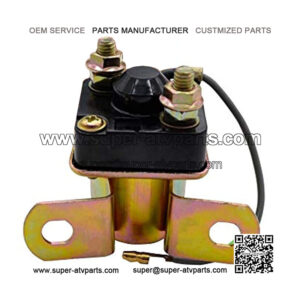Here are the answers to some frequently asked questions on the solenoid:
1. Where Is The Starter Solenoid Located?
If you pop open your engine compartment, you can follow the positive battery cable to the starter motor. The starter motor is often bolted to the engine or transmission, and the solenoid is almost always attached to it.
2. What Are Common Starter Solenoid Problems?
Here are few common ways the starter solenoid fails:
- The solenoid pull-in coil fails
- The holding coil doesn’t release the solenoid metal contacts
- There’s a defective connection between the solenoid and starter motor
- Burned out solenoid contacts keep the starter motor turning even with the ignition and drive gear disengaged
3. What Are The Signs Of A Faulty Starter Solenoid?
A faulty starter solenoid can exhibit several symptoms, including these:
- Engine doesn’t crank: This is a result of the starter solenoid failing to deliver power to the starter motor
- No clicking sound: This can mean either a faulty starter solenoid or starter relay
- Starter motor spins without fully engaging the flywheel: This is usually because of a weak solenoid that doesn’t engage the starter gear (pinion gear)
- Engine cranks slowly: High resistance in your solenoid burns out the solenoid contacts, creating excessive resistance in the starter motor, causing slow cranking
4. What Symptoms Can Mimic A Bad Starter Solenoid?
Some symptoms from other issues can mimic those of bad starter solenoid. If there’s no problem with the solenoid, you could be looking at these problems instead:
- A dead starter battery that delivers no power to the solenoid
- A corroded battery terminal or loose battery cable that reduces power to the solenoid
- Loose wiring or cables can create a bad electrical connection
- Issues within the starting circuit that stop the starter motor from functioning
- A seized engine that doesn’t respond to cranking
5. What Are The Terminals On A Starter Solenoid?
The starter solenoid typically has 3 or 4 terminals on its insulating cover — two large ones and one (or two) smaller ones.
The two larger terminals are usually copper bolts:
- Solenoid terminal B (or 30) is for the positive battery cable
- Solenoid terminal M (or C) connects with the starter terminal on the starter motor
The smaller terminals are typically iron bolts:
- Solenoid terminal S (or 50) is for the control wire connecting to the starter relay and ignition switch
- If there is a 4th terminal, this can be terminal R (connects to a ballast resistor) or I (connects to the ignition coil) — this terminal is usually not used
The solenoid shell also acts as an invisible grounding terminal.
6. How Can I Bypass The Starter Solenoid?
One way to check if you have a solenoid or starter motor problem is by bypassing the solenoid using an insulated screwdriver.
Here’s what to do:
Locate The Control And Starter Motor Terminals
Find these two metal terminals on the starter solenoid:
- A small one that connects a wire to the ignition switch (terminal S)
- A large one that connects the solenoid to the starter motor (terminal M)
Short The Terminals With The Screwdriver
Place the metal blade of the insulated screwdriver across both metal terminals. Doing this bypasses the solenoid, creating a direct connection between the ignition switch and the starter motor.
Turn On Ignition
Get a second pair of hands to turn on the ignition key.
Because the solenoid is bypassed, the engine won’t start, but the starter motor gets some power to run at lower speeds.
Listen To The Starter Motor
Listen for starter motor sounds.
If there’s steady humming, the motor is fine, and the solenoid is likely defective. If the motor doesn’t start or sounds choppy, then the motor likely has problems.
If this is too much of a hassle, it’s probably simpler to call a mobile mechanic to troubleshoot your starting system.
7. How Is A Failing Starter Solenoid Checked?
To check if the solenoid appears faulty, your mechanic will generally take these steps:
- Test the battery with a voltmeter or multimeter: There will be a slight voltage drop during engine cranking. However, a weak battery won’t even have enough voltage to crank the engine in the first place.
- Check if the solenoid is receiving power: Issues in the control circuit can prevent the solenoid from receiving the current to energize.
- Test the solenoid with a multimeter: Your mechanic will use a multimeter to test for electrical continuity or resistance.
8. How Can I Get My Solenoid Fixed?
Bad solenoid symptoms often seem similar to starter motor or battery issues.
To get your solenoid fixed and make sure your starting system is healthy, it’s always best to let a professional deal with it. A mobile mechanic is an even better option as they can come to you.
About Starter Solenoid
“starter solenoid”
“starter solenoid symptoms”
“starter solenoid test”
“starter solenoid replacement”







